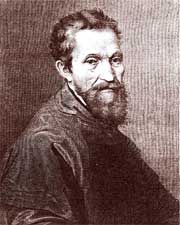Michelangelo - Biography
Michelangelo biography is singularly entangled with the history of the time. A full history of Michelangelo would imply the study of the passage from the faith and society of the Middle Ages to the beginning of the modern world. His life closes the end of the Old World and begins the New. The invention of the art of printing had just been made and was beginning to establish new forms of education, to make the learning of the past accessible and to hasten the change in religious and social life.

Michelangelo Buonarroti
Michelangelo Biography - Early years
Michelangelo Buonarroti was born in a centre of political, literary, religious, and artistic evolution. Florence, to which he belonged, was a centre of thought, culture, and trade, and was passing from the ancient idea of the rights and liberties of the City to forms of modern tyranny and more centralized government.
Here is the record of his birth, as written by his father, Leonardo Buonarroti Simoni, in his private note-book: "I record that on this day, March 6, 1474, a male child was born to me. I gave him the name of Michelangelo, and he was born on a Monday morning, four or five hours before daybreak; and he was born while I was Podestà of Caprese; and he was born at Caprese; and the godfathers were those I have named below." Skipping the names, we note that the date is 1474, according to Florentine usage; according to Roman usage it is 1475.
Michelangelo's biography written by Condivi states that "the planets were propitious at this birth and showed how great was to be this little child, and of how great genius, because as Mercury and Venus entered with benign aspect into the House of Jupiter this promised - as in fact did follow - that such a birth was to be that of a noble and high capacity, fit to succeed universally in any undertaking, but particularly in those arts which please the senses, like painting, sculpture, and architecture."
When Michelangelo was born, his father was Podestà, or governor, of Caprese. He was born in an ancient family of distinguished descent, going back in ancestry to the beginning of the 13th Century. The family held very strongly to this special distinction of origin, which in the Florence of that date marked a special class.
Indeed, the Buonarroti family claimed origin from the Counts of Canossa, illustrious not only by their antiquity, but also by their connection with imperial blood. Beatrice, the sister of Henry II, the Emperor, married that Boniface of Canossa to whom was born the famous Countess Matilda, who held in Italy, among other places, what was once called the Patrimony of St. Peter.
In his biography of Michelangelo, Condivi is relating about the claimed origin, as many objections were made to this high descent. It appears that in 1520, Alexander, Count of Canossa, wrote to Michelangelo claiming this connection, and calling himself "your good relative." Michelangelo also attached great importance to this descent, and a certain personal pride and sense of obligation marked his character. This sense of high descent stood by him in his relations with the great, and separated him from the mass of artists and artisans, accustomed to greater subservience than he could allow himself.
At the termination of his term in office, the father returned to Florence and Michelangelo was given to nurse to a woman of Settignano, where the family had a villa which still stands. Michelangelo's foster mother was the daughter and wife of stone-cutters and Michelangelo reasonably attributed his predilection for sculpture to this first childish impression. The little village almost exclusively inhabited by stonemasons and workers in marble, exercised a decisive influence on the child's future career. A mallet and a chisel and bits of marble were the only toys that the infant Michelangelo cared for, and it is recorded that at ten years of age he could use the tools almost as skilfully as his foster-father himself. He went to school in Florence, and is said to have learned no more than reading, writing, and Italian, because he complained later that he knew no Latin; but that may have been from his modesty or from his pride; we shall see him later writing in Latin and not ill. Michelangelo's acquaintance with the boys in Florence, apprentices to masters in painting and sculpture, developed in him a strong desire for such life.
Michelangelo's biography is recording the opposition from his family, who took it hard, and even beat him on that account. They yielded, however, and we have the record which binds him as an apprentice in the painter Ghirlandaio's workshop, on the First of April 1488, for three ensuing years.
Michelangelo Biography Continued:
Michelangelo and Lorenzo de' MediciMichelangelo in Rome and Florence
Michelangelo's return to Rome